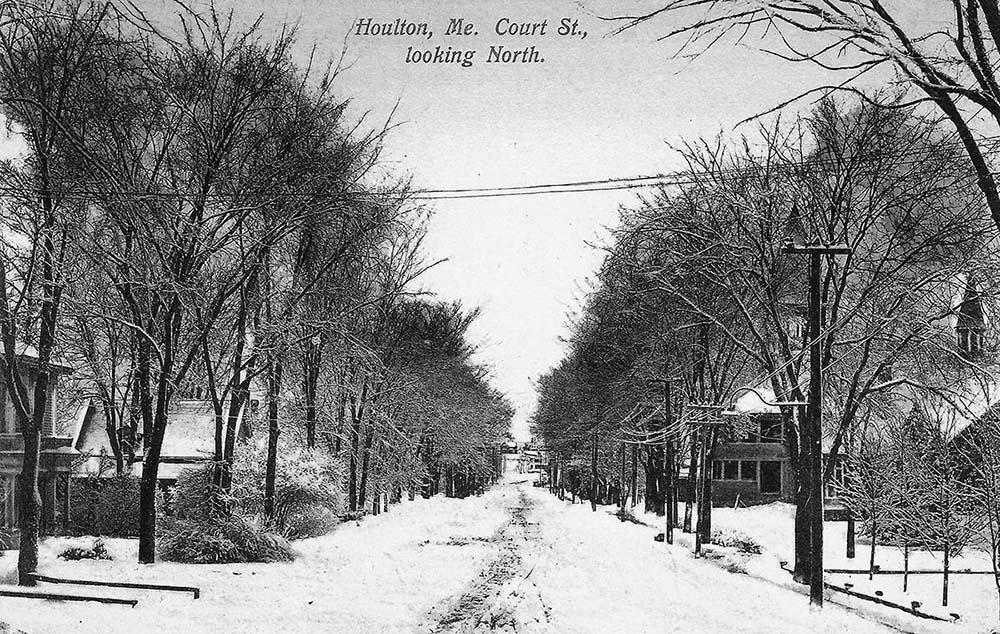“The true meaning of life is to plant trees, under whose shade you do not expect to sit,” Nelson Henderson
When I look at old pictures of the beautiful tree-lined streets of Houlton from the early 1900s,
I think that Houlton’s forefathers would have agreed with Henderson. Talk to some of the older folks who grew up in Houlton, and they will tell you of streets such as Court, Main, Military, and Highland and High graced by stately and mature elms and maples. The elms on Court Street reached out from each side of the street to form an archway in places. They understood the aesthetic importance of trees in the environment.
These trees didn’t just happen to grow along the streets. Looking at old photos of Houlton, one realizes they were planned plantings. The trees were all about the same age and planted in straight rows along the streets. This was not just after the fire of 1902. Photos showing the devastation of this fire show charred trees among the ruins that were fairly mature. Lost structures were 111 but there was no account of lost trees. Monument Park was born from the ashes of this fire when that area was cleaned up. Photos from 1905-10 show young maples planted all around the park. Some of these are the maples we sit under today to listen to McGill’s Band on Thursday nights and to eat lunch from The Bus in the summer. Imagine Monument Park without these trees. Other photos between 1905-08 show new plantings on High Street, one of the residential streets hit by the fire of 1902.
The next effort at improving Houlton’s tree population was in 2007. A group of concerned citizens had a goal of planting 200 trees to celebrate Houlton’ Bicentennial. This time disease resistant maples and elms were selected. Many of these were planted on Court, Maine, and Military Streets. Some of these have been lost to pests and weather. For around 20 years the town and chamber have planted street trees downtown with the help of grants. The first ones were lost mostly from lack of proper care, and second and third rounds were planted. They too are struggling but are so worth fighting to keep which Jane Torres, the executive director of the chamber, and a few others keep doing. Walking down the street and smelling their flowers and seeing and hearing the birds as they flit about in them, make the fight a worthwhile one.
However, like every other living thing, trees don’t live forever. The first blow to these majestic trees planted after the fire came in the 1960s and 1970s in the form of Dutch Elm Disease. Barely an elm survived. An American elm is rare in Houlton (and many other places) today because of its susceptibility to the disease.
The maples fared better as far as disease, but they are coming to the end of their life span (about 125 years for a street tree) and are falling down in pieces and having to be taken down. Very few replacements have been planted. Some trees only in their 40s or younger have been cut down around town for unclear reasons. Hopefully, replacements will be planted soon. On my walks around town, I notice so many young trees, mostly maples, growing where the seed happened to fall. This is usually in the middle of a homeowner’s lilac bush or other shrub or against the foundation of their house. I fantasize about rescuing each one and replanting it in a proper location where it could thrive and enhance rather than encroach and damage. Houlton streets are beginning to look very bare in many places and our charming town is losing its curb appeal.
Diseases aren’t the only enemies of our town trees. Multiple stressors such as road salt, plows, weed wackers, dogs, pruning for power lines and pollution threaten our trees today whether they are downtown or in our yards. Apathy, lack of plant knowledge, ability, and time are also enemies. It is possible, however, to nurture and protect our green infrastructure. When we landscape our homes with trees and plants, we see it as an investment for our current enjoyment and future property value. Don’t we want to make that same investment in our community?
It will take resources, a good continuous plan, and hard work, but the return on environmental impact and community enhancement will be so worth it. It was obviously a priority for Houlton’s early citizens and a few others over the years. Are we going to continue it today? No, you may never sit under one of the trees you plant and enjoy its shade and splendor as the seasons change, but it’s an act of love and a legacy you can leave to show you care. As Thomas Fuller (a prolific author in 17th century England) said, “He that plants trees loves others besides himself.”








